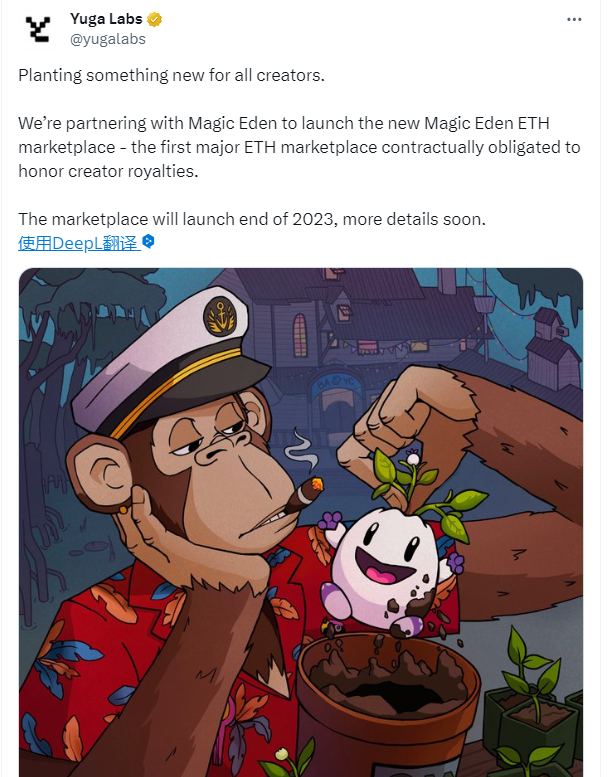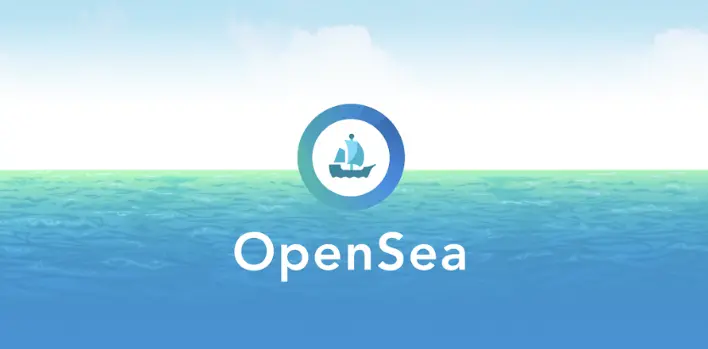Layoffs, valuation cuts, market squeeze, OpenSea falls from grace
Author: Grapefruit, ChainCatcher
On November 4th, OpenSea was reported to have laid off 50% of its staff, which was later confirmed. However, this personnel change is not the first for OpenSea; back in July of last year, OpenSea had already laid off 20% of its workforce due to the impact of the crypto winter and macroeconomic instability, leaving approximately 230 employees at that time. After this latest round of layoffs, only a little over a hundred employees remain.
On November 8th, it was revealed that OpenSea's largest investor, Coatue, had written down the value of its shares in OpenSea from $120 million to $13 million as early as Q2 2023, a 90% reduction. This move also suggests that OpenSea's current valuation is equal to or below $1.4 billion, a nearly 90% decrease compared to its peak valuation of $13.3 billion in early 2022.
Additionally, according to data from DappRadar, the number of daily active wallets on OpenSea has dropped below 8,000, with daily trading volume around $3 million, down from over $1 million just two months ago, while the number of daily active wallets during peak times exceeded 50,000, with daily trading volume exceeding $100 million. In the past week, OpenSea's market share in the NFT trading market has fallen below 35%, while its competitor, the aggregated NFT trading platform Blur, has captured over 50% of the market share (approximately 53.7%).
"Layoffs exceeding 50%, valuation shrinking by nearly 90%, market share squeezed to below 35%"—these negative phrases related to OpenSea have recently flooded various crypto communities. As a barometer for the development of the NFT market, every move of OpenSea resonates deeply with industry insiders.
How did OpenSea, once the leading NFT trading platform and a model for crypto unicorns, fall to such a state? Who pushed this "big ship" of OpenSea off its peak? Is it the overall cooling of the NFT market or issues with the platform's own development? Faced with the current predicament, how will OpenSea find a way out?
Who pushed OpenSea off its pedestal?
Founded in 2017, OpenSea once dominated the entire NFT trading market due to its first-mover advantage, achieving a trading volume of $5 billion in January 2022 during the peak of the metaverse and NFT boom, with an average daily trading volume exceeding $100 million. It completed a $300 million Series C funding round led by Paradigm and Coatue, and was regarded as a unicorn in the crypto space. Now, OpenSea's status is "only a little over a hundred employees left, valuation shrunk to $1.4 billion, and NFT trading market share below 35%."
What exactly caused OpenSea, the former leader in NFT trading, to fall from grace?
We may find some clues in the changes in its platform trading volume. OpenSea's platform trading volume experienced a cliff-like drop in June 2022, plummeting from over $3 billion per month to below $1 billion (with May at $2.6 billion and June dropping to $700 million).

The main reason behind this is the overall cooling of the crypto market, which led to a sharp decline in NFT market trading volume and a bleak market. According to data from The Block, the NFT trading volume in June 2022 was only $1.04 billion, a 74% decrease compared to the $4 billion in May. This is reportedly the largest decline in NFT market history.

Following this, in July, OpenSea announced a 20% layoff. In response, OpenSea co-founder and CEO Devin Finzer stated that under various potential downturn scenarios, the current trading volume would allow OpenSea to maintain normal operations for five years. Just one year after this layoff, OpenSea announced another 50% layoff.
Moreover, with the boom in the NFT market, OpenSea faced increasing competition, and the NFT trading market transitioned from being dominated by one player to a more diverse landscape.
In early 2022, competitors like LooksRare and X2Y2, known for their trading mining initiatives to counter OpenSea's centralization, began to emerge. In addition to Ethereum, mainstream public chains represented by Solana launched their own native NFT trading platforms (such as Magic Eden), and a number of high-quality NFT projects (like DeGods) emerged, leading to a decentralization of the NFT market and a shift of user traffic from Ethereum to other public chains, eating into OpenSea's market share. Centralized exchanges also announced their own NFT platforms, with Binance launching Binance NFT and OKX launching OKX NFT, along with specialized NFT platforms like Artblocks (art), SuperRare (crypto art curation), Adius (music), and NFT batch trading aggregators like Gem and Genie.
However, these products did not shake OpenSea's position as the leader in NFT trading until the emergence of the NFT aggregation trading platform Blur in October 2022, which changed the landscape.
Blur quickly established itself in the NFT market with advantages such as token airdrop incentive strategies, zero trading fees, and customizable royalties, surpassing OpenSea in trading volume and becoming the largest NFT trading platform.
Data from Dune shows that since Blur's launch, OpenSea's market share has been severely squeezed, remaining below 50% for an extended period, and even dropping below 35% multiple times.

According to the latest statistics released by NFTGO on October 28, in the past 30 days, Blur's monthly trading volume was 115,700 ETH, while OpenSea's trading volume was only 49,600 ETH, with the former being more than double the latter. Additionally, the average trading volume per address on Blur was higher, at 0.76 ETH, compared to OpenSea's 0.13 ETH, with these figures being 2.87 ETH and 0.43 ETH three months prior.


Overall, the overall bear market in the crypto market has more significantly impacted the trading volume of NFT platforms, while the real change in OpenSea's market share has come from the Blur platform. Under Blur's aggressive assault, OpenSea's market share has steadily declined from an initial peak of 90% to between 50% and 30%, pushing OpenSea off its throne as the king of NFT trading platforms.
OpenSea's self-rescue counterattack: Launching zero-fee OpenSea Pro to regain market share, changing royalty rules sparks controversy
In the face of the relentless pressure from Blur, OpenSea did not remain passive but instead proactively adopted a series of strategies to respond. Among these, the launch of the product OpenSea Pro and the cancellation of the mandatory royalty policy are the most representative actions. However, from the final results and community feedback, it seems these measures did not meet official expectations and instead sparked some controversy.
First, OpenSea added OpenSea Pro to its product line. In April of this year, OpenSea announced a brand upgrade for the previously acquired, independently operated NFT aggregation platform Gem, renaming it OpenSea Pro, aimed at attracting professional users and competing with its rival Blur.
The OpenSea Pro platform features innovative functionalities such as real-time cross-market data, advanced orders, robust inventory management, instant sales, optimized gas fees, watch lists, real-time minting overviews, and bulk transfers. However, in terms of product functionality design, it largely borrowed ideas from Blur, adopting a zero trading fee model and focusing on NFT trading aggregation, offering trading rewards and airdropping Gemesis NFTs to historical Gem users.
In April of this year, OpenSea Pro airdropped approximately 95,000 Gemesis NFTs to early Gem users, with the current floor price of this NFT being 0.0145 ETH. Although the official statement indicated that this NFT is only for commemorative purposes and has no intrinsic value, it is still viewed by its community users as an important basis for future OpenSea token airdrops.

According to the latest data from Dune, OpenSea Pro is currently the third-largest NFT trading platform in the market, following Blur and OpenSea, with a market share of about 8%. If the market shares of OpenSea and OpenSea Pro are combined, the total is not far off from Blur.
 From the data, the launch of OpenSea Pro has helped OpenSea regain some market share.
From the data, the launch of OpenSea Pro has helped OpenSea regain some market share.
However, on August 18 of this year, OpenSea's announcement to "cancel mandatory creator royalties and change to optional creator fees" made it a target of criticism, facing protests from multiple parties. Royalties are fees paid to the original NFT creators, typically ranging from 2.5% to 10% of the resale price.
OpenSea announced that starting from August 31, 2023, it would implement an optional mechanism for creator fees, canceling the mandatory creator royalty tool (Operator Filter). For NFT series currently using mandatory royalties, OpenSea will enforce the previously specified creator fees until February 29, 2024, after which creator fees will be optional. From August 31, new series will have optional creator fees.
In simple terms, starting from March 2024, NFT sellers will have the freedom to set the revenue share for their NFT resales. If they set the share to 0, then creators will not earn any revenue from subsequent NFT transactions. Sellers can also choose to pay more fees if they wish.
The adjustment of OpenSea's royalty mechanism may be related to the market difficulties it was experiencing at the time. On one hand, the bear market in crypto has led to a continuous decline in NFT prices and trading volumes, indicating a waning interest in NFT trading, which has affected platform revenue. Lowering royalties might bring in more trading volume. On the other hand, the current NFT market advocates for a zero-royalty trend, with platforms like Blur and LooksRare opting for optional royalty mechanisms, while others like SudoSwap have adopted zero royalties. OpenSea, facing a continuous loss of market share, needed to attract more trading users to change this situation.
OpenSea's implementation of the optional royalty mechanism has faced significant controversy, with Mark Cuban and Yuga Labs publicly opposing OpenSea's royalty change policy.
As an investor in OpenSea, Mark Cuban expressed disappointment on social media, stating that OpenSea's decision not to collect and pay royalties on NFT sales is a huge mistake that undermines trust in the platform and harms the entire industry.
Yuga Labs, as a representative of the NFT industry, led the protests and announced it would gradually stop supporting all upgradable contracts on OpenSea SeaPort and any new series, planning to fully withdraw from the OpenSea market by February 2024.
However, on the same day that OpenSea announced a 50% layoff, Yuga Labs announced a partnership with the NFT trading platform Magic Eden to jointly launch a new NFT market on Ethereum that would allow for creator royalties by the end of this year.

In fact, there are both supporters and opponents of OpenSea's royalty reform. Opponents argue that the optional or zero royalty strategy may attract NFT traders in the short term but is a shortsighted strategy. In the long run, the lack of royalty income will diminish creators' motivation to create, which is detrimental to the continued innovation and development of NFTs. Moreover, for creators, the more fatal issue is that with OpenSea also shifting to an optional creator royalty model, it means that there is no leading trading platform supporting mandatory royalties. As the market is already sluggish, creators' earnings are facing significant reductions. If there are no royalties, how is this different from Web2 or real-world art?
Supporters argue that the current existence of royalties is detrimental to NFT liquidity and can further exacerbate losses for investors facing losses.
Just one day after OpenSea announced the implementation of optional royalties (August 22), OpenSea Pro subsequently announced that with the adjustment of creator fees, it would start charging a 0.5% platform fee on all OpenSea listings and sell orders created on OpenSea Pro starting from August 31. Community users reacted negatively to this action, commenting that they would have to pay fees for listings, while creators would receive nothing, and the platform would benefit even more.
From the reactions of creators and users to OpenSea's changes in royalty policy and arbitrary fee settings, it appears that OpenSea's policies still follow a self-serving principle, without genuinely considering the users' perspective, focusing more on increasing the platform's revenue.
Can OpenSea 2.0 break the OpenSea dilemma?
Currently, the evaluation of OpenSea is more negative than positive, but as the former leader in NFT trading, it still has the most NFT trading users. According to statistics from NFTGO, the number of active traders on OpenSea is three times that of Blur.

However, the NFT trading space is now very crowded, with not only up-and-coming players like Blur, challengers like LooksRare and X2Y2, but also centralized exchanges like Binance's Binance NFT, OKX NFT Marketplace, and multi-chain representatives like Magic Eden. Although OpenSea has a first-mover advantage in terms of users and NFT numbers, if it continues to adhere to a "self-centered" approach without focusing on users, its advantages may gradually diminish, and it could even be replaced by new platforms.
Now, with the crypto market warming up, the NFT market is also showing an upward trend. Can OpenSea regain its king status in the upcoming bull market?
In fact, in response to this round of layoffs, OpenSea co-founder and CEO Devin Finzer stated that the future would involve repositioning the team around OpenSea 2.0: changing operational methods, shifting to a smaller team, directly connecting with users, and undertaking a major upgrade of the product, including foundational technology, reliability, speed, and user experience.
However, the specific details about what products and functionalities OpenSea 2.0 will upgrade and its future development roadmap have not been disclosed to the public. Nonetheless, many in the community view OpenSea 2.0 as a self-rescue strategy for OpenSea, which is of great significance for OpenSea to extricate itself from its current predicament, with some even believing that its success or failure hinges on this move.
Although the future strategy of OpenSea 2.0 remains uncertain, recent public actions by OpenSea suggest that "multi-chain operations" and "how to enhance the NFT creator experience" will be part of it. For instance, today (November 10), OpenSea announced a five-week on-chain creator art competition in collaboration with Optimism, offering 1 million OP tokens as rewards for on-chain creators. In October, OpenSea launched the NFT developer open-source toolkit Shipyard, providing a standardized set of tools for NFT creators to help them build various types of NFT projects.
Additionally, regarding multi-chain layout, many users predict that OpenSea will soon integrate with the Bitcoin ecosystem. Currently, Bitcoin has become the second-largest NFT ecosystem, with a trading volume of $76.78 million in the past 30 days, compared to $227 million on the Ethereum chain. Platforms like Binance NFT and OKX NFT Marketplace have already supported Bitcoin NFTs, and recently Binance launched the BRC20 token representing ORDI, indicating optimism for the future of the Bitcoin ecosystem.

OpenSea's layout in the Bitcoin ecosystem, however, seems somewhat sluggish, as it has yet to release any information regarding support for Bitcoin NFTs.
Some opinions suggest that OpenSea's delay in integrating with the Bitcoin ecosystem is a strategic misstep, missing the golden development period of the Bitcoin ecosystem (May and June) and the emerging market that could have attracted new users. In contrast, multi-chain NFT market Magic Eden, after shifting to support the Bitcoin ecosystem this year, not only gained a batch of new users but also contributed over 60% of its trading volume during the explosive growth of the Bitcoin ecosystem in May. However, in October, Magic Eden announced a suspension of support for BRC20 token trading.
Furthermore, for users, OpenSea has a significant ace up its sleeve that has yet to be revealed, which is related to tokens. Although OpenSea has been operating under the standard IPO route and has previously been reported multiple times regarding IPO-related news, the recent airdrop of NFTs to historical Gem users during the launch of OpenSea Pro has once again given users hope.
The crypto market winter will eventually pass, and the NFT market will return to prosperity. However, whether OpenSea will still be the leader in the next bull market remains a question mark. For NFT creators, their primary concern is whether OpenSea will continue to be creator-centric and provide sustainable revenue from royalties to incentivize their creative enthusiasm. It is evident that OpenSea's current optional royalty policy does not meet these requirements.










